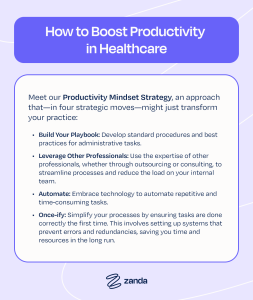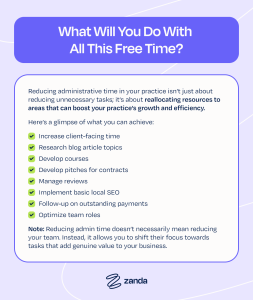No one starts a healthcare practice to allow administrative duties to dominate their time. Still, it’s an all-too-common challenge – especially when resources are tight and every minute counts.
This article is based on a recent Power Talks webinar, Slash Admin Time and Increase Productivity, in which Zanda Co-Founder Damien Adler and Fiona Harrington, Head of Strategy, Marketing and Growth, discuss surprisingly simple strategies for slashing admin time while supercharging productivity in healthcare.
Let’s explore practical strategies that have helped our customers reclaim time each week by streamlining their admin tasks.
How Does Admin Interfere with Profitability?
Administrative tasks are vital to running any healthcare practice, but when they’re cumbersome and poorly executed, they can interfere with overall profitability.
Admin affects profitability by:
- Eating into Crucial Time: Inefficient or overly complex administrative tasks don’t just consume time; they eat into periods that could otherwise be spent on strategic planning and improving client services. Every minute spent navigating complicated, paper-based administrative processes is a minute not spent with clients or on activities that enhance your practice.
- Increasing Risk of Burnout: The burden of excessive admin tasks falls heavily on practitioners and administrative staff, making burnout an all-too-real threat. Spending a disproportionate amount of time on paperwork instead of client care can lead to stress and job dissatisfaction, impacting the quality of care provided and increasing staff turnover rates.
- Raising Staff Costs: To manage the load, practice owners might need additional admin staff. This increases operational costs significantly. More staff not only means higher salary expenditures but also increases expenses for training, benefits and workspace. These costs, if not managed wisely, will thin your margins.
How to Boost Productivity in Healthcare & Reduce the Admin Burden
Enhancing health practitioner productivity while reducing your administrative burden isn’t just a goal to aim for – it’s entirely achievable.
Meet our Productivity Mindset Strategy, an approach that – in four strategic moves – might just transform your practice:
- Build Your Playbook: Develop standard procedures and best practices for administrative tasks. This playbook becomes your go-to guide, ensuring consistency and efficiency across all operations.
- Leverage Other Professionals: Don’t go it alone. Use the expertise of other professionals, whether through outsourcing or consulting, to streamline processes and reduce the load on your internal team.
- Automate: Embrace technology to automate repetitive and time-consuming tasks. From client scheduling to billing, automation tools can drastically reduce the time spent on manual entries and follow-ups.
- Once-ify: Simplify your processes by ensuring tasks are done correctly the first time. This involves setting up systems that prevent errors and redundancies, saving you time and resources in the long run.
Move #1: Build Your Playbook
Well-organized administration processes are the backbone of any successful healthcare practice. That’s why the first step to improving productivity in healthcare is to create a comprehensive practice operations manual. This will serve as the foundation for your practice’s procedures and policies, ensuring that everyone knows what needs to be done, as well as when and how.
This manual should be your practice’s blueprint. It details everything from your daily operations to emergency procedures.
The following are streamlined admin operations you can build into your playbook today:
- Batch Tasks: Designate specific days for routine tasks to streamline your week. For instance, make Friday your bank and post office day. This simplifies decision-making and ensures these tasks are handled efficiently, freeing up the rest of your week for client-focused activities.
- Personal Appointments and Time Blocking: Block time in your calendar for client appointments and administrative duties. Whether it’s an errand day, system reviews or note completion, having dedicated time slots helps maintain focus and efficiency for improved health practitioner productivity.
- Simplified Systems and Schedules: Use systematic schedules for recurring tasks like clinic cleaning or maintenance checks. Include these in your operations manual and set up calendar reminders to ensure they’re never overlooked.
- Supplier Lists: Keep a curated list of commonly used suppliers with their contact information and ordering specifics. This makes reordering supplies as straightforward as possible and ensures you’re never out of essentials.
- Prioritize Essential Service Payments: Pay essential service providers promptly – even if they offer a 30-day payment schedule. Quick payment can build good relationships, making it more likely they’ll prioritize your needs in an emergency.
- Communication Policies: Set clear expectations for your availability. Use your voicemail or automated messages to inform clients of your working hours and how they can book appointments or reach you in urgent situations. For example: “We won’t check this phone until Monday morning. If it’s urgent, please contact XYZ.”
- Financial Policies and Tools: Establish firm policies around fees and payments. Collect payments upfront or on the same day of the service. Consider integrating payment solutions like Stripe to securely collect and store client credit card details for smoother transaction processing.
- Appointment Scheduling: Adjust your appointment slots to include time for administrative tasks between sessions. For instance, scheduling 45-minute appointments instead of hour-long sessions allows for 15 minutes of admin or note-taking time, enhancing overall productivity without sacrificing client care.
Move #2: Leverage Other Professionals
Delegation may be one of the most underrated ways to streamline your operations and boost those profit margins.
The old adage “time is money” holds true because every minute you spend on non-essential tasks is a minute taken away from your clients.
Free up your time by:
- Outsourcing Non-Core Duties: Tasks like bookkeeping, accounting, and cleaning are essential but can distract from client care. Outsourcing these duties can free up time, allowing you to concentrate on what you do best – caring for clients.
- Setting Correct Permissions for Admin Staff: Empower your administrative staff with the right permissions to handle tasks without constant oversight. This delegation streamlines operations, builds trust and enhances staff morale.
- Automating Routine Supply Orders: Put routine tasks on autopilot wherever possible. Whether it’s subscribing to regular deliveries of office supplies or arranging for weekly flower deliveries to brighten up the waiting room, automation can remove small but time-consuming tasks from your plate.
- Creating an Aspirational Practice Model: Always keep the vision of your ideal practice in mind. Model your systems and behaviors to align with this vision, ensuring every process contributes to your goals.
- Leveraging Your Time, by:
- Valuing Your Time: Always remember that your professional time isn’t free. Think of your charge per hour as a baseline for deciding whether a task is worth your personal attention.
- Delegating Effectively: If someone else can do a task as well or better, outsource it. Focus your personal efforts on areas where your unique talents are most needed and valued.
- Considering the Opportunity Cost: Every task you undertake has an opportunity cost. Understand the limitations of your energy, brainpower and time. Use these resources wisely, focusing on activities that offer the greatest return in terms of client outcomes and practice growth.
- Creating a Culture of Continuous Improvement: Encourage a learning attitude toward mistakes. Take note of recurring issues (like running out of supplies) and develop systems to prevent these oversights.
- Establishing Processes and Standards: Set clear processes and standards for tasks you delegate. This ensures your staff completes tasks successfully and to a high, replicable standard.
Move #3: Automate
This is where it all starts to come together – if you can automate some of your most essential operations, you’re playing to win.
Automation is a vital tool for reducing the administrative burden in your practice. Automating repetitive and time-consuming tasks can free up your time and focus more on client care and practice growth.
- Enable Online Booking: Implement online booking systems to remove yourself from the scheduling equation. Allowing new clients to book appointments directly reduces the need for back-and-forth communication to confirm times and dates.
- Automate Client Intake: Automate your intake process by sending forms automatically when clients book appointments online.
- Email & SMS Appointment Reminders: Automate appointment reminders via email and SMS. This ensures that clients are well-informed and reduces no-shows and last-minute cancellations.
- Automate Financial Transactions: Streamline your billing process by automating invoicing and post-appointment recall messages.
- Track Sessions Effortlessly: Use tools like session packs to manage multiple sessions efficiently, ensuring clients and therapists are on the same page regarding remaining sessions and their usage.
Move #4: Once-ify
“Once-ifying” involves doing tasks once so they either don’t have to be done again or can be completed much more quickly next time.
A powerful way to apply this principle in your practice is through the use of templates in Zanda:
- Notes: Implement templates for clinical notes to speed up the documentation process dramatically. Instead of starting from scratch each time, templates provide a structured format you can quickly fill in, ensuring consistency and saving time.
- Letters: Similarly, use templates for common letters and communications sent to clients, other healthcare providers, or insurance companies. This speeds up the writing process and maintains a professional and consistent tone across all your communications.
By fully integrating templates into your practice, you can “once-ify” many routine tasks, freeing up time to focus on providing quality client care and growing your practice.
This approach will streamline your operations and enhance your practice’s overall efficiency and professionalism.
What Will You Do With All This Free Time?
Reducing administrative time in your practice isn’t just about reducing unnecessary tasks; it’s about reallocating those resources to areas that can significantly boost your practice’s growth and efficiency.
Here’s a glimpse of what you can achieve:
- Increase Client-Facing Time: With fewer administrative burdens, you and your clinical staff can spend more time with clients. More client time means more opportunities to generate revenue, making your practice more profitable and impactful.
- Research Blog Article Topics: Enable your team to spend time on content creation, such as researching and writing blog articles that establish your practice as a thought leader in the field.
- Develop Courses: Assign your team to develop educational courses to serve as additional revenue streams or enhance client care.
- Develop Pitches for Contracts: Use extra resources to put together compelling pitches for potential contracts or partnerships, expanding your practice’s reach and influence.
- Manage Reviews: If appropriate for your practice, allocate time for managing online reviews, which can be important for maintaining a positive online reputation and attracting new clients.
- Implement Basic Local SEO: Have team members keep your business profiles updated in online directories, enhancing your practice’s online visibility and making it easier for new clients to find you.
- Follow-Up on Outstandings: If previous efforts to collect on outstanding accounts have been unsuccessful, consider using saved admin time to focus on debt collection outreach, improving your financial stability.
- Optimize Team Roles: Reducing admin time doesn’t necessarily mean reducing your team. Instead, it allows you to shift their focus towards tasks that add genuine value to your business. This strategic shift enhances job satisfaction by providing more engaging work and directly contributes to your practice’s growth and success.
Conclusion
By adopting strategies like automating routine tasks, leveraging professional help and using templates, you can transform your practice’s admin operations so you can focus more on business growth and client care.
Ready to cut the administrative burden in your practice? Try Zanda today and discover how our suite of tools can help. Start your 14-day Free Trial now and get 50% off for your first 6 months!







